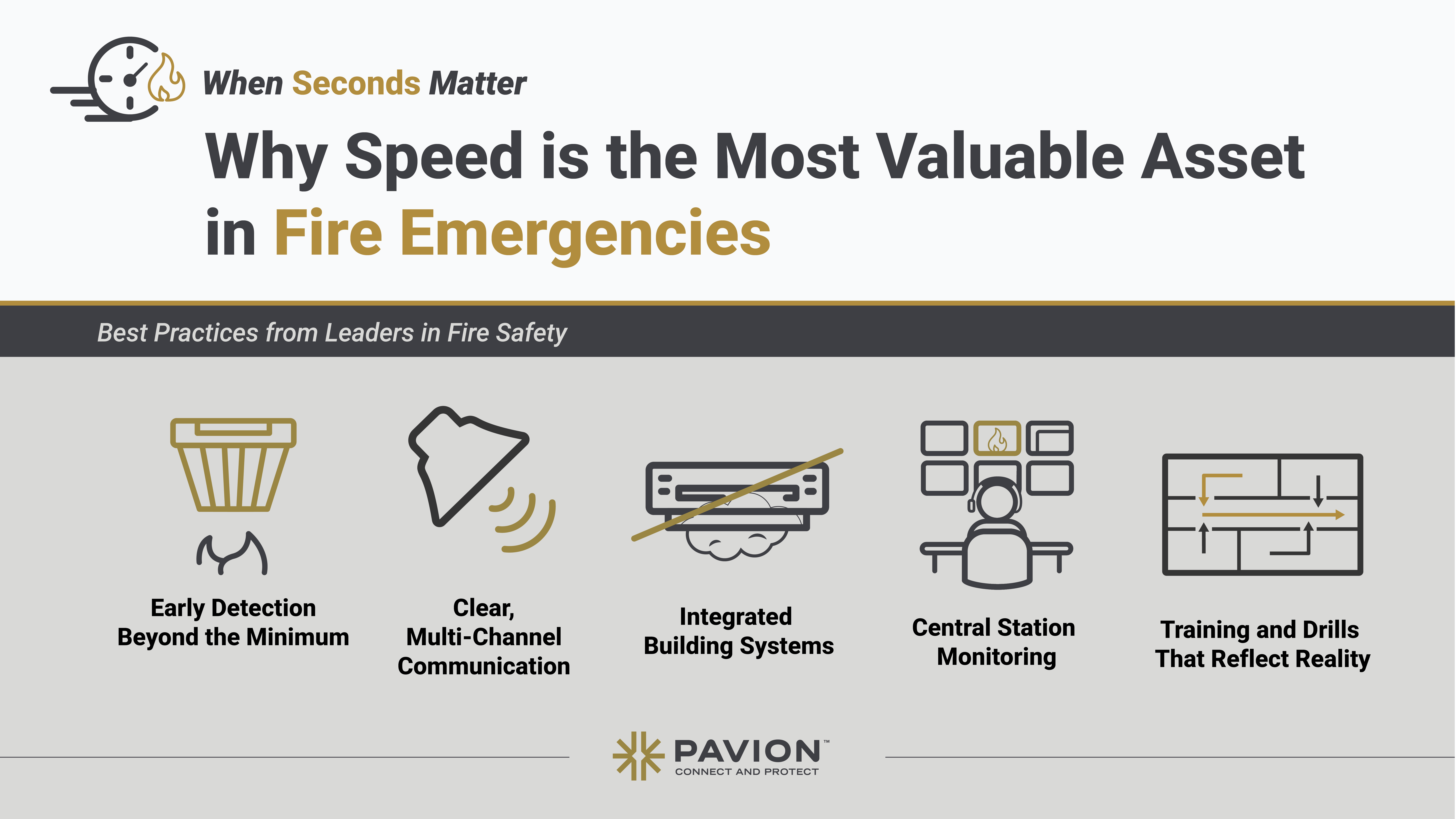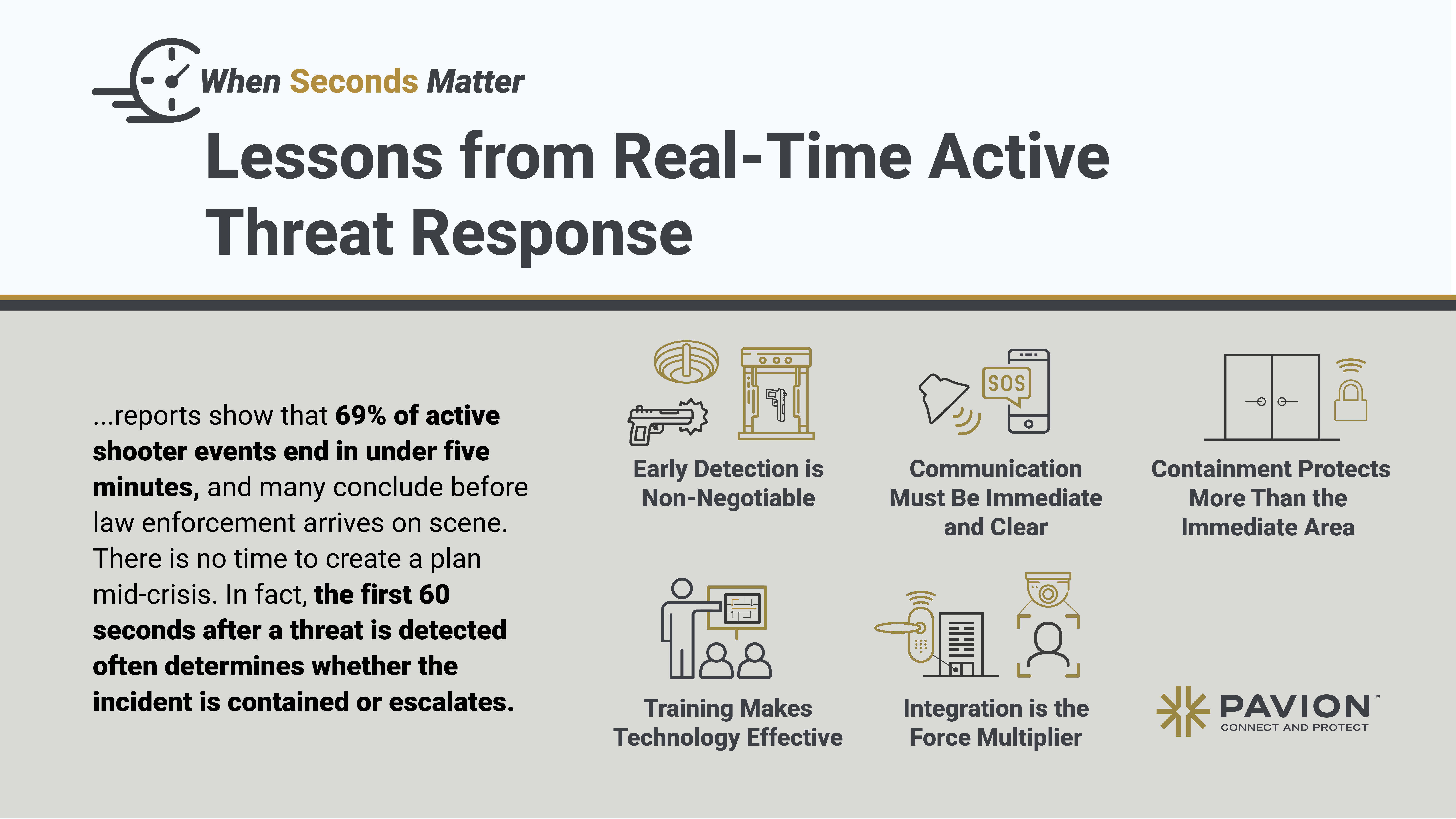
When Seconds Matter: Why Speed is the Most Valuable Asset in Fire Emergencies
The Unforgiving Nature of Fire
Fires are among the most time-sensitive emergencies any organization can face. According to the National Fire Protection Association (NFPA), a fire can double in size every 30 seconds. That rapid growth transforms small, containable incidents into large-scale disasters in mere minutes.
In those early moments, time is the single most valuable asset. The speed with which you detect, communicate, and act will determine not only the level of property damage but whether everyone walks away safely. And yet, too often, fire preparedness plans focus narrowly on compliance rather than on the practical realities of life safety.
Why Seconds Count
In a fire, the danger doesn’t come only from flames. Smoke inhalation, structural instability, and blocked egress routes can make escape impossible if action isn’t immediate. The sequence of events in a poorly prepared environment often looks like this:
- A fire starts, often unnoticed at first.
- A person spots smoke or smells something burning.
- They alert others nearby and eventually notify security or call 911.
- Building alarms are activated—sometimes manually, sometimes delayed.
- Occupants begin to evacuate, often without clear direction.
- Emergency responders arrive minutes later, by which point conditions have worsened.
That gap between ignition and protective action is where lives are lost. Every second of delay is time for the fire to grow and the danger to multiply.
High-Risk Environments
While every building is at risk, some settings carry heightened fire danger due to the number of people present, the complexity of the layout, or the nature of the operations inside:
- Hospitals and healthcare facilities where evacuation is complex.
- High-rise office buildings with vertical evacuation challenges.
- Industrial facilities where combustible materials are present.
- Education campuses where young occupants need clear, rapid guidance.
- Public assembly venues like stadiums and theaters.
In each, the challenge is the same: how to compress the timeline from detection to evacuation into the shortest window possible.
Best Practices from Leaders in Fire Safety
1. Early Detection Beyond the Minimum
Modern fire safety leaders go beyond standard smoke detectors, implementing intelligent systems that sense smoke, heat, or flame patterns early—even before visible cues appear to occupants. In high-risk environments, detection tied to air sampling systems can identify microscopic particles, buying crucial minutes.
2. Clear, Multi-Channel Communication
Sirens and strobes are important, but they’re not enough. People need specific, actionable instructions in real time. The best systems integrate:
- Public address systems for voice guidance.
- Visual alerts for the hearing impaired.
- Mobile notifications that reach occupants regardless of location.
When messages are automated and pre-scripted for different scenarios, there’s no hesitation or confusion about what to say in the moment.
3. Integrated Building Systems
An effective fire safety plan links alarms to other building systems so that life safety actions happen instantly:
- Fire doors close to contain smoke and flames.
- HVAC systems shut down to prevent smoke spread.
- Elevators recall to safe floors to prevent use during evacuation.
- Lighting adjusts to illuminate exit paths.
Integration ensures these steps happen without relying on human intervention during a high-stress event.
4. Central Station Monitoring
For facilities that aren’t staffed around the clock—or even for those that are—central station monitoring ensures that alarms immediately notify trained operators who contact emergency services without delay. This removes dependence on someone on-site making the call and ensures a verified, consistent response every time.
5. Training and Drills That Reflect Reality
Technology is powerful, but it’s only as effective as the people who use it. Progressive organizations run regular, scenario-based fire drills that:
- Vary the location and type of simulated fire.
- Incorporate blocked exits to test adaptability.
- Include coordination with local fire departments.
These exercises uncover weak points in both technology and human response, allowing teams to refine procedures before a real emergency strikes.
A Realistic Scenario
Consider a 20-story commercial building with mixed office tenants. A small electrical fire starts in a 9th-floor server room. In a conventional setup, it might take minutes before anyone notices smoke, alerts security, and activates the alarm—by which point evacuation routes may already be compromised.
In a well-prepared facility, however:
- Air sampling sensors detect combustion particles immediately.
- Mass notification reaches all floors with clear voice and text instructions.
- Fire doors and HVAC systems activate automatically to contain the hazard.
- Central monitoring dispatches the fire department before anyone manually calls.
The difference between these two scenarios isn’t luck—it’s a deliberate investment in readiness.
Looking Ahead: Designing for Speed
Fire preparedness isn’t just about passing inspections—it’s about designing environments where every second works in your favor. That means:
- Choosing detection systems that sense threats early.
- Integrating communication and building controls for immediate, automated action.
- Training people to respond instinctively and effectively.
Organizations that approach fire safety as an active, integrated discipline—not a checkbox exercise—position themselves to protect both people and property when it matters most.


